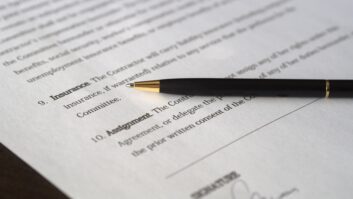Economic and Political Considerations Can Trump Technical Ones at the FCC
Paul McLane’s interview with Ed De La Hunt (“De La Hunt Troubled by HD Radio,” Feb. 1) elicited quite a response. The March 29 Reader’s Forum featured four favorable letters – all of them as critical of IBOC as they were supportive of Ed De La Hunt – while a fifth letter, unconnected with the interview, also criticized the Ibiquity system.
But only one of the four letters also mentioned De La Hunt’s comments on the AM stereo mess of the 1980s, and that’s too bad.
Why? Because the FCC showed the same kind of poor judgment in choosing Motorola’s C-Quam system over Leonard Kahn’s independent sideband (ISB) system as they showed in choosing Ibiquity digital technology over Kahn’s Cam-D for AM and over Digital Radio Express’s FMeXtra for FM. And they made a similar mistake with analog FM stereo 45 years ago.
Abandonment issues
Consider Walt Lowery’s apparently tongue-in-cheek letter (Feb. 1). He opened by expressing surprise that one Salt Lake City broadcaster, which had recently begun simulcasting an AM news format on an FM station, had not turned off the stereo generator, and ended by suggesting that once a majority of listeners are able to receive “HD Radio,” all stations should abandon analog stereo.
I’ll return to that point, but let’s consider the merit of this presumably facetious proposal.
Lowery pointed out there’s a significant difference between the signal strength necessary for good “quieting” for reception of stereo and that required for equally noise-free reception of a mono FM signal; high-end FM tuners have published specs with differences ranging from 20.8 to 26 dB, depending on the quality of the circuitry. Of course, the difference can be even greater in a boombox. And 20 dB is a power factor of 100, while 26 dB is a factor of 400.
As he said, imagine cutting your transmitter power that much. Maybe mono has something to recommend it not only for FM news and talk stations, but also for adult standards and “real oldies” stations that play a lot of mono music.
But there’s one other important thing to consider: In the stereo mode, the L+R modulation level is held to 45 percent. And remember the frequency swing corresponds to the audio signal voltage, not to power. So the power output at the detector is only slightly over one-fifth (0.2025) of that from a mono signal of equal strength, or -6.94 dB. (And it’s even worse with SCAs, where it’s -7.85 dB.) So there’s a coverage advantage even on mono receivers that ignores the stereo difference and pilot.
Crosby, signals and hash
In retrospect, we should have adopted Murray Crosby’s all-FM system in April 1961. With an FM subcarrier system and a receiver with good limiting in the subchannel, the stereo S/N ratio would be much better on all but the weakest signals. But there were two reasons the FCC went with the GE-Zenith 19-kHz pilot system we’re still using.
First, that was the vacuum tube era – though the first solid-state FM tuners would appear by the end of the year – and the additional tubes for an all-FM system would have increased the size, weight, cost of and heat generated by each tuner or receiver.
Second, and this was probably the clincher, the Crosby system would have ended SCA services. Many FM stations lost money on their primary service, but kept solvent by leasing their SCA subcarriers. And the biggest SCA customer in those days was Muzak. In fact, many FM owners also were Muzak franchisees that used their own stations’ subcarriers, and a few of them were in a position to exert real influence on the FCC; for example, then-Vice President Lyndon Johnson.
As De La Hunt said, the FCC erred again in the 1980s by adopting Motorola’s C-Quam system for AM stereo. I remember the tests of Leonard Kahn’s independent sideband (ISB) system in the late 1970s. I could get AM stereo reception not only from WFIL (560) in nearby Philadelphia, but also from the ground wave of what was then WNBC (660) 90 miles away in New York.
The audio quality was better than I expected. It really didn’t sound any worse than some over-processed FM CHRs that were putting all their records on less-than-hi-fi NAB carts. And the best part was that, unlike C-Quam, Kahn’s ISB system didn’t make the station any wider.
Of course, De La Hunt also was right about the proposed 5 kHz limit on analog bandwidth. There’s no reason to limit bandwidth during daylight hours, and there’d be no need to with Cam-D.
But while AM IBOC’s appropriation of five channels is outrageous, FM IBOC’s use of half of each adjoining, or “first-adjacent,” channel is hardly innocuous.
Since Philadelphia lost its full-time classical station, I’d like to be able to hear WQXR (96.3) from New York. Until recently, that might have been possible.
But what good would the best possible tuner and antenna be when Beasley’s CHR Rhythmic WRDW(FM) 96.5 in Philadelphia is running IBOC, with its lower side channel effectively jamming the upper half of WQXR(FM)’s weak 96.3 analog signal from New York?
And that’s not the only problem with “HD FM.” When two second-adjacent stations both use IBOC, each taking up half of the channel between them, they become in effect first-adjacents, at least with respect to their digital signals.
Want concrete examples?
WSTW(FM) 93.7 in Wilmington, Del., is a second-adjacent to both WMMR(FM) 93.3 and WYSP(FM) 94.1 in Philadelphia, both of which are running IBOC. IBOC signals from WSTW wreak havoc on those two Philadelphia stations’ IBOC signals south of the city. And what about WPST(FM) 94.5 in Trenton, N.J.? That one would interfere with WYSP’s IBOC north of Philadelphia, too. There are dozens of such situations around the country.
If nobody’s noticed the problem yet, that’s only because IBOC receivers automatically default to analog whenever the digital signal is too weak for adequate reception, provided there is an analog signal. Of course, once the stations pull the plug on analog to add more digital program streams – or switch their analog service to mono to extend their useable coverage area, as per Walt’s suggestion – the problem will become immediately obvious.
Hasn’t anybody thought this thing through? And whose idea of progress is this anyway? It’s all too obvious that when technologies compete, economic and political considerations can trump technical ones at the FCC.












